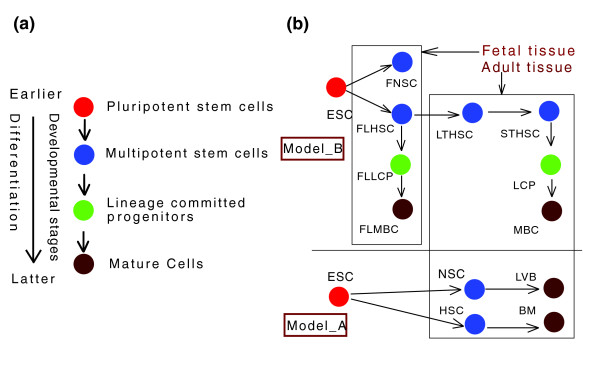Figure 1.

Cell types of different developmental stages in two models of stem cell differentiation. (a) Cell types of earlier developmental stages can differentiate into cell types of later developmental stages. The arrowheads indicate the direction of differentiation. Pluripotent stem cells (PSCs) occupy the earliest developmental stage, as they can give rise to all cell types of the three germ layers. PSCs can generate less potent 'multipotent stem cells' (MSCs), which are capable of generating all the cell lineages in specific tissues. MSCs can, in turn, give rise to lineage-committed progenitors (LCPs), which directly produce mature cells in the later developmental stage. (b) Two models of stem cell differentiation in our research. The cell type colors correspond to the developmental stages shown in (a). The arrows indicate the direction of differentiation within differentiation pairs made up of two neighboring stages in the developmental hierarchy. Model A [54] contains pluripotent embryonic stem cells (ESCs), MSCs in adult hematopoietic (hematopoietic stem cells (HSCs)) and neural (neural stem cells (NSCs)) tissues, as well as the main cell populations in bone marrow (BM) and the cells in lateral ventricles of the brain (LVB), which mainly contain mature cells in adult hematopoietic and neural tissues, respectively. Model B [55] contains ESCs and three types of MSCs that reside in fetal neural (fetal neural stem cell (FNSCs)), fetal liver hematopoietic (fetal liver hematopoietic stem cells (FLHSCs)) and adult hematopoietic (long-term functional hematopoietic stem cells (LTHSCs)) tissues. Model B also includes the key intermediate developmental stages of the hematopoietic hierarchy. In adult bone marrow, short-term functional HSCs (STHSC) and bone marrow LCPs are intermediate developmental stages in the course from LTHSCs to mature blood cells (MBCs). Fetal liver LCPs (FLLCPs) comprise an intermediate developmental stage between FLHSCs and FLMBCs. (For a detailed description of each cell type and experimental evidence of these differentiation processes, see Table 1 and Discussion).
